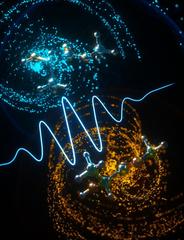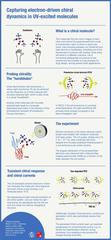URL: https://www.desy.de/news/news_search/index_eng.html
Breadcrumb Navigation
DESY News: Scientists decipher the contribution of electrons to molecular chirality
News
News from the DESY research centre
Scientists decipher the contribution of electrons to molecular chirality
A new experimental approach provides the long-awaited tools to understand the role of electrons in the molecular chiral reactivity and offers a way to control physical and chemical properties that result from chiral interactions. The study, published in the journal “Nature”, was led by Universität Hamburg and DESY as part of a collaboration with the Centre Laser Intense et Applications (CELIA) and the Laboratoire de Chimie et Physique Quantiques (LCPQ) in France and the Max Born Institute in Berlin.

An ultrashort UV light pulse excites two chiral molecules that are mirror images of each other, called enantiomers. The light-induced electron motion generates a chiral electronic current whose rotation direction is opposite and depends on the chiral structure of each molecule; an enantio-sensitive phenomenon which is opening new perspectives for photochemical control. Image credit: Ella Maru Studio, Inc.
The static and dynamic properties of chiral molecules can be shaped by using light. So far, only the light-activated structural dynamics have been considered to affect the chiral response of molecules. This leaves a fundamental question unanswered: What is the impact of electron dynamics on molecular chirality?
Using ultrashort ultraviolet light pulses, the team initiated ultrafast electron migration in neutral chiral molecules. They discovered that the activated coherent electronic motion can modulate the molecular chiral response and even induce a sign reversal, on a timescale below 10 femtoseconds. “By engineering the light-induced excitation, we can make the right enantiomer act periodically like the left one and vice versa, without changing its structure,” says first author Vincent Wanie, scientist in the Attosecond Science group at the Center for Free-Electron Laser Science CFEL at DESY. This was observed by measuring in time the emission direction of photoelectrons produced when ionizing chiral molecules with circularly polarised light, which is also chiral, a technique called photoelectron circular dichroism (PECD).

Infographic explaining the scientists' experiment
Original publication:
‘Capturing electron-driven chiral dynamics in UV-excited molecules’, Wanie V. et al., Nature (2024)
DOI 10.1038/s41586-024-07415-y



